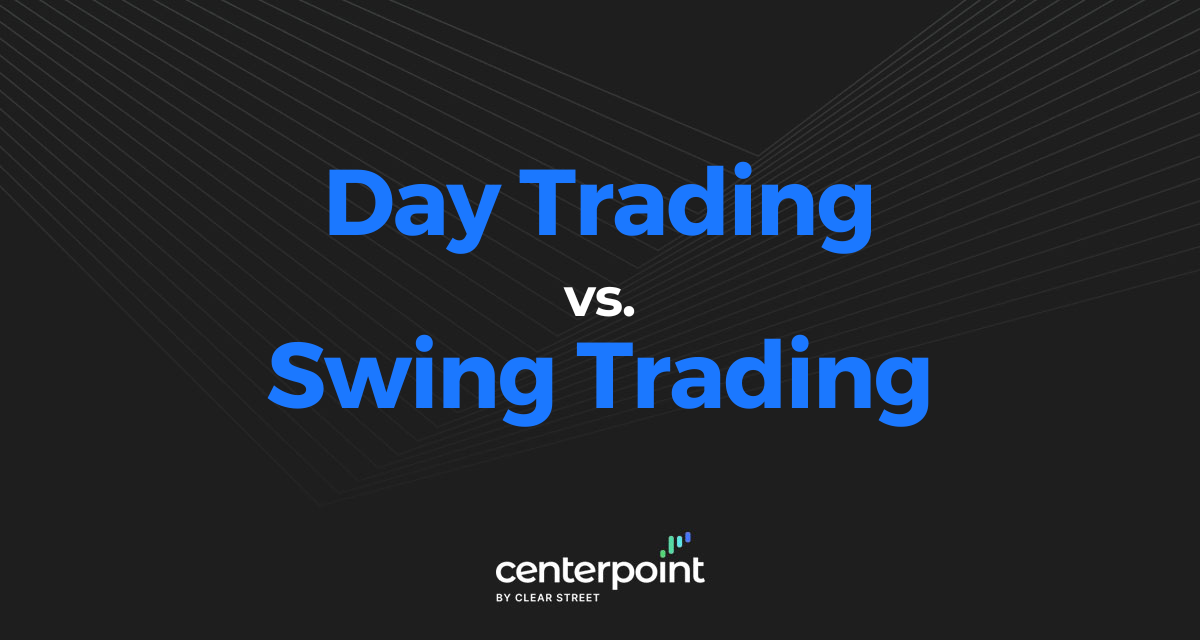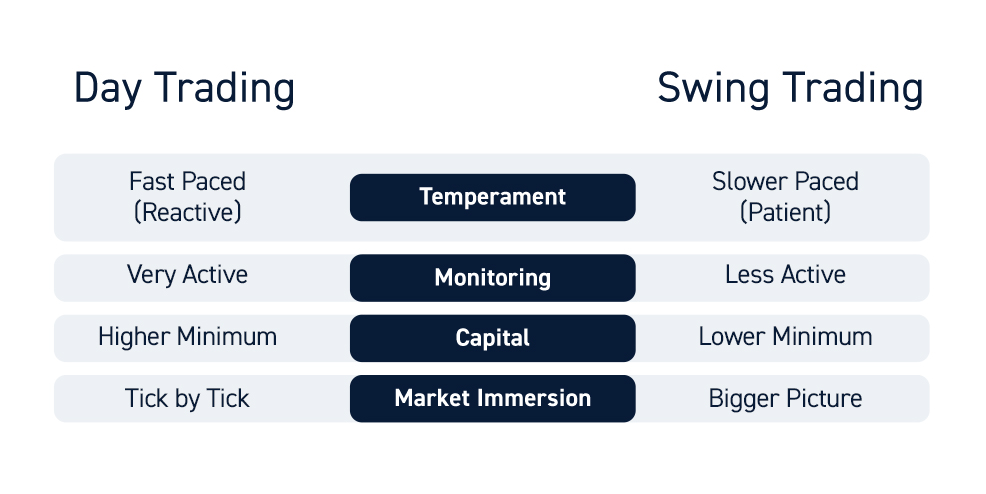As they say in professional boxing, “styles make fights”. You have explosive punchers like Mike Tyson knocking out opponents inside a single round and methodical boxers like Floyd Mayweather that routinely go the full distance for decision wins. Trading is very similar in terms of styles. Many traders have an affinity for one of two distinct styles, day trading or swing trading. Seasoned traders understand the distinction between the two and which style they tend to favor. Knowing which market conditions favor one style over the other is key.
What is Day Trading?
Day trading is an aggressive style of actively trading intraday positions. Day traders seek to capitalize on intra-day momentum and price volatility utilizing shorter holding periods to close out positions.
Day trading is a style that prioritizes smaller time frames charts like the 1-minute and 5-minute to capture quick price moves intraday. This type of trading often utilizes leverage with heavier share positions offset by smaller holding times. With day trading, the goal is to end the trading day in cash to avoid overnight exposure. Trades can last from minutes to hours, but they are all closed out by the end of the day. It requires nimble trading with precision execution and timing.

What is Swing Trading?
Swing trading is a style of trading that focuses on larger price swings over a wider time horizon. This style implements larger time frame charts like the daily, weekly and monthly. It also integrates longer holding periods that can range from overnight to multiple day and week positions. Swing trading requires patience and endurance to weather the near-term price swings within the context of a larger price trend.
Similarities Between Day Trading and Swing Trading
Right off the bat, it’s imperative to make clear that trading is not investing, which adopts a passive buy and hold theme. Investing implies that you will buy and hold a stock for years at a time.
While there are stark contrasts in trading styles, day trading and swing trading are two sides of the same coin. They both share the same end goal, which is to zero out exposure by closing out positions for a profit or a loss. The difference is how quickly positions are closed out. Day traders limit exposure to intra-day only whereas swing traders take overnight risk spanning from a day to weeks before closing out.
Both styles require active management. Day trading requires more active management tracking the smaller time frame charts to execute quick trades in the context of a larger pattern. Swing trading takes advantage of larger time frames to focus on the bigger picture pattern and avoid the “noise” on smaller time frames. This requires less active management since fewer trades are being executed in favor of bigger price moves.
Trade the Set-Ups, Not the Companies
Both styles focus on price action and trading price pattern set-ups more than the underlying companies. Traders understand the disconnect between a stock and the underlying company operations. While stocks are supposed to be an indication of the underlying business, the reality is they are trading instruments that oscillate on share supply and demand that don’t necessarily reflect the everyday operations of the company. Since stock prices can fluctuate for numerous reasons that aren’t pinned to company specific news, trading focuses generally on the price action.
Analysis
Both day and swing trading emphasize the analysis of price action utilizing charts and technical analysis. Technical analysis focuses solely on the stock price, how it got here and where it’s going. Trade analysis is used to anticipate risk vs. reward scenarios of trades before executing and managing them.
Trading Methodologies
Whether day trading or swing trading, both styles still require having a trading methodology to implement trading strategies with sound trade management. Trading methodologies are linear across all time frames. The difference is the share allocations and holding periods. A pattern that forms on a 5-minute chart can form on a daily chart. The difference is the time it takes for the pattern to play itself out. Whereas a 5-minute pattern may trigger in a matter of minutes and run for an hour, a daily pattern may take two-days to trigger and run for a week. This adjustment of time frames sounds easy on paper. However, in reality, it is incredibly tough psychologically. Some people have a temperament for instantaneous results, while others prefer extended waiting periods to let the bigger picture play out.
Tools of the Trade
There are two type of tools that traders may need: research tools and execution tools. Research tools help the trader perform analysis on the stock and execution tools enable the trader to perform and manage the trade. Both tools can be found on a trading platform through your online broker. However, the quality of the tools differ based on the type of online broker. The best direct market access (DMA) brokers will have high caliber execution tools and should have robust trading research tools as well.
Differences Between Day Trading and Swing Trading
The core distinction between day and swing trading is time frames. Day trading focuses on intraday whereas swing trading focuses on days to weeks. That sounds easy, but the actual management becomes more complex. Since day trading uses smaller time frames, traders try to capture smaller price moves with larger shares for quicker outcomes. To offset the risk exposure, smaller holding times are required.
Swing trading utilizes wider time frames for longer holding periods. Since risk is all about exposure in terms of position size and holding time, the risk here is generally offset by taking smaller share positions. Larger time frame set-ups take more time to come to fruition, which means positions can be subject overnight risk and intraday price fluctuations. Again, smaller positions need to be taken to offset the short-term wiggles and noise.
Goals
Of course, the goal of any trade is to make a profit. However, day and swing trading have different approaches. Day trading may take advantage of smaller price moves spanning from a few pennies to a few percentage points depending on the set-up. Results are obtained quickly with all positions usually closed out by the end of the day avoid overnight risk. Since larger sizing is used, the incremental prices moves can be lucrative with a focus on high probability price moves in the smaller amount of time. Of course, day traders can also pursue higher percentage point moves, but these types of intraday moves aren’t as frequent.
Swing trading seeks to take a larger price gain by holding positions longer in conjunction with wider time frames. This can take anywhere from a day to weeks as they seek out larger price moves ranging from 10% to 20%+. In doing so, they bypass smaller price gains and absorb the wiggles for a bigger picture move. This requires offsetting that risk with smaller positions.
Analysis
Day trading is heavy on technical analysis, focused solely on the price action. Utilizing intraday charts, day trading seeks to anticipate the forward trajectory of a stock price based on the historical pattern. Smaller and near-term price moves are analyzed using 1-minute to 60-minute intraday charts.
Swing trading utilizes wider time frame charts ranging from 60-minute to monthly. It can also implement fundamental analysis, researching the operations of the underlying business operations, valuations, financial metrics and its catalysts to determine if shares are adequately priced. Utilizing both technical and fundamental analysis, swing traders analyze the larger price trends and also try to offset overnight risk with fundamental research (IE: undervalued, strong balance sheet, upcoming product release/event catalyst).
Tools of the Trade
Day trading requires robust real-time intraday charting and instantaneous precision trade executions. To enhance potential profit opportunities, intraday price/news scanners also empower day traders to find more ideas. However, this can also spread the trader thin if they are jumping in on too many trades as overtrading is a key pitfall with this style.
Swing trading can be enhanced with the same tools as a day trader including robust charting and execution tools along with scanners and news feeds. The swing trader looks for larger price moves and will utilize the same charts but on larger time frame charts. In fact, swing traders usually avoid smaller time frames so as not to get wiggled out on noise or slippage. Out of sight is out of mind. Since fewer trades are being made, the direct routing of executions is not as high a priority for a swing trader. However, executions are always a factor with trading and utilizing smaller time frames for buy and sell triggers signals complemented by direct routing execution can enhance results.
Which Type of Trading is Best For You?
Neither swing trading nor day trading is objectively better. The better trading style is relative to the trader.
Which type of trading is best suited for you relies on outside factors in addition to inherent internal factors. To help you determine which style suits you best, here are since questions to consider:
What is Your Temperament?
Do you prefer immediate results and closure? Day trading is fast paced and requires nimble reactions and discipline. It also an investment in terms of time, training and scheduling but the pay-off is quicker results.
If your persona is more laid back and patient, then swing trading offers a slower pace. If you’re patient enough to wait longer for results but disciplined enough to take stop-losses as premeditated, then swing trading can work for you.
What does your schedule look like?
Day trading requires more intense screen time, especially between 8:30am EST to 10:30am EST. This allows for an hour of pre-market research. If those hours are available for you, then it’s a style worth considering. Swing trading is more lenient since you will be holding for multiple days to possibly weeks. However, it still requires attention and monitoring.
How Much Capital are You Trading With?
The Pattern Day Trading (PDT) rule requires a minimum of a $25,000 balance in order to day trade without limitations. Failing that, you are limited to just three intraday round trips every five trading days. This means unless you have more than $25,000 in your account, you are stuck primarily as a swing trader.
How Active Do You Want to Be?
If you are passionate about the stock market and want to be fully immersed in the day to day action, then day trading might be right up your alley. If you want to watch the markets all day and have an insatiable hunger to be a student of the markets and you have in excess of $25,000 of risk capital, then day trading is a style that may suite you.
If you prefer not to watch the market tick-by-tick and want to remain semi-passive, then swing trading may suit you. If your forte is analyzing charts and the underlying Company operational performance and metrics to form a bigger picture narrative, then swing trading may be your trading style preference.








